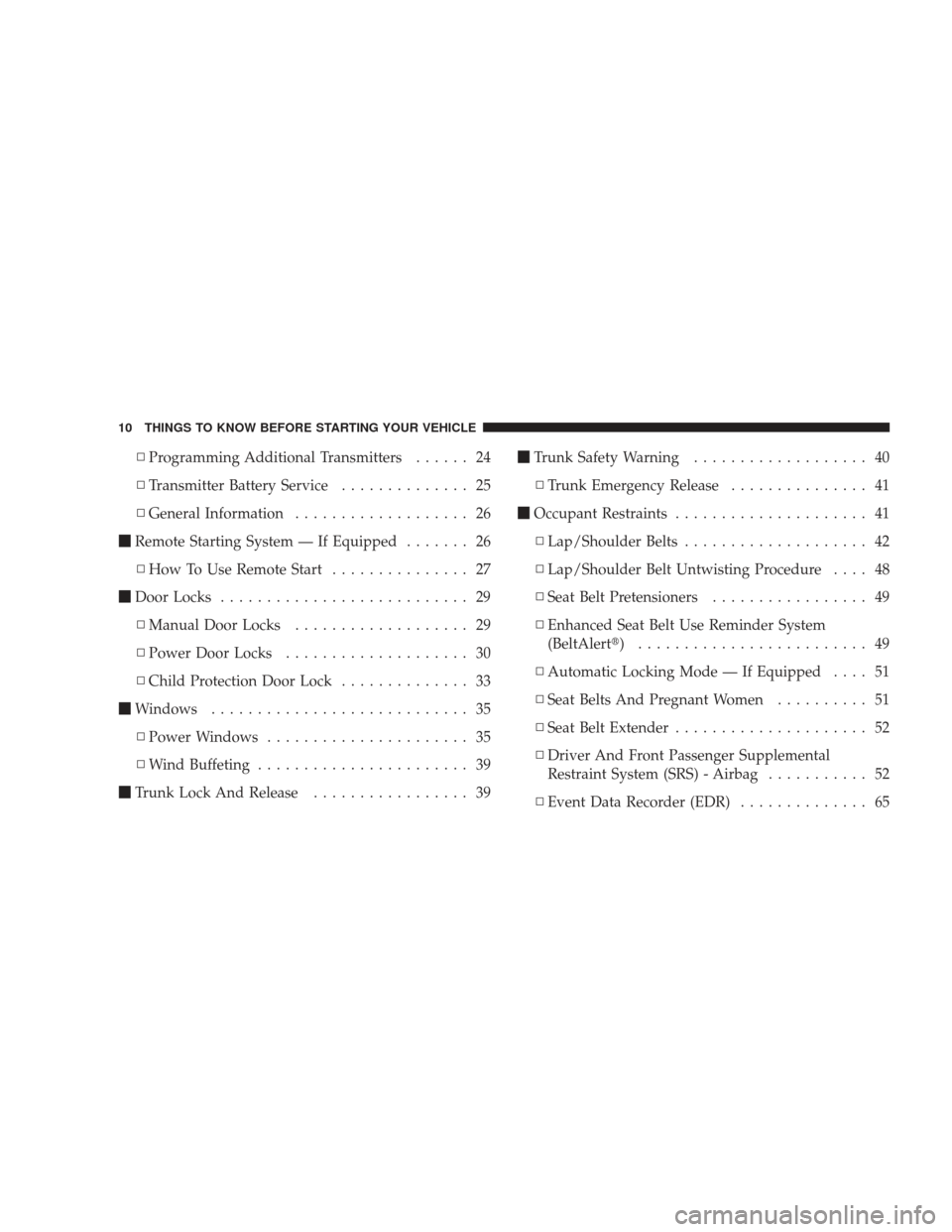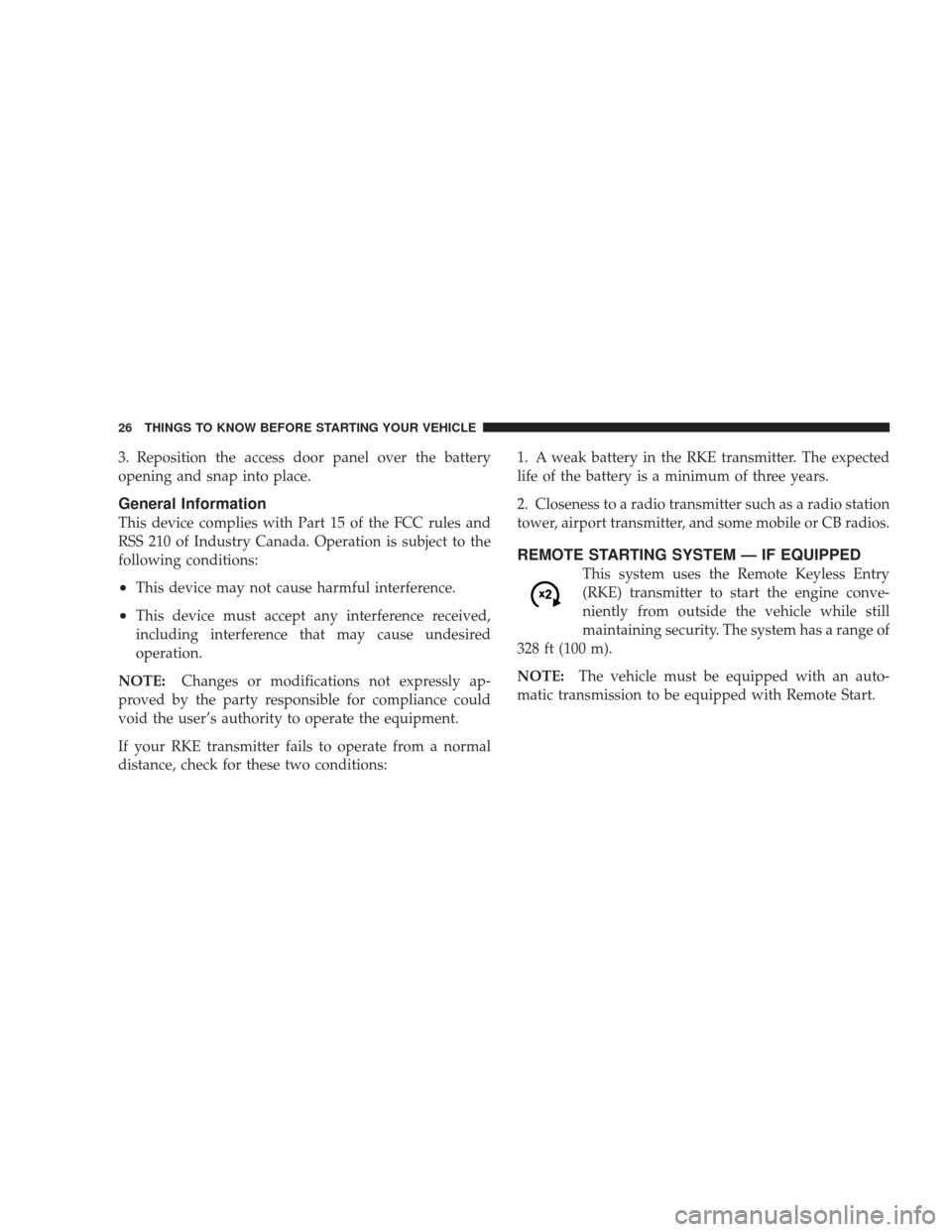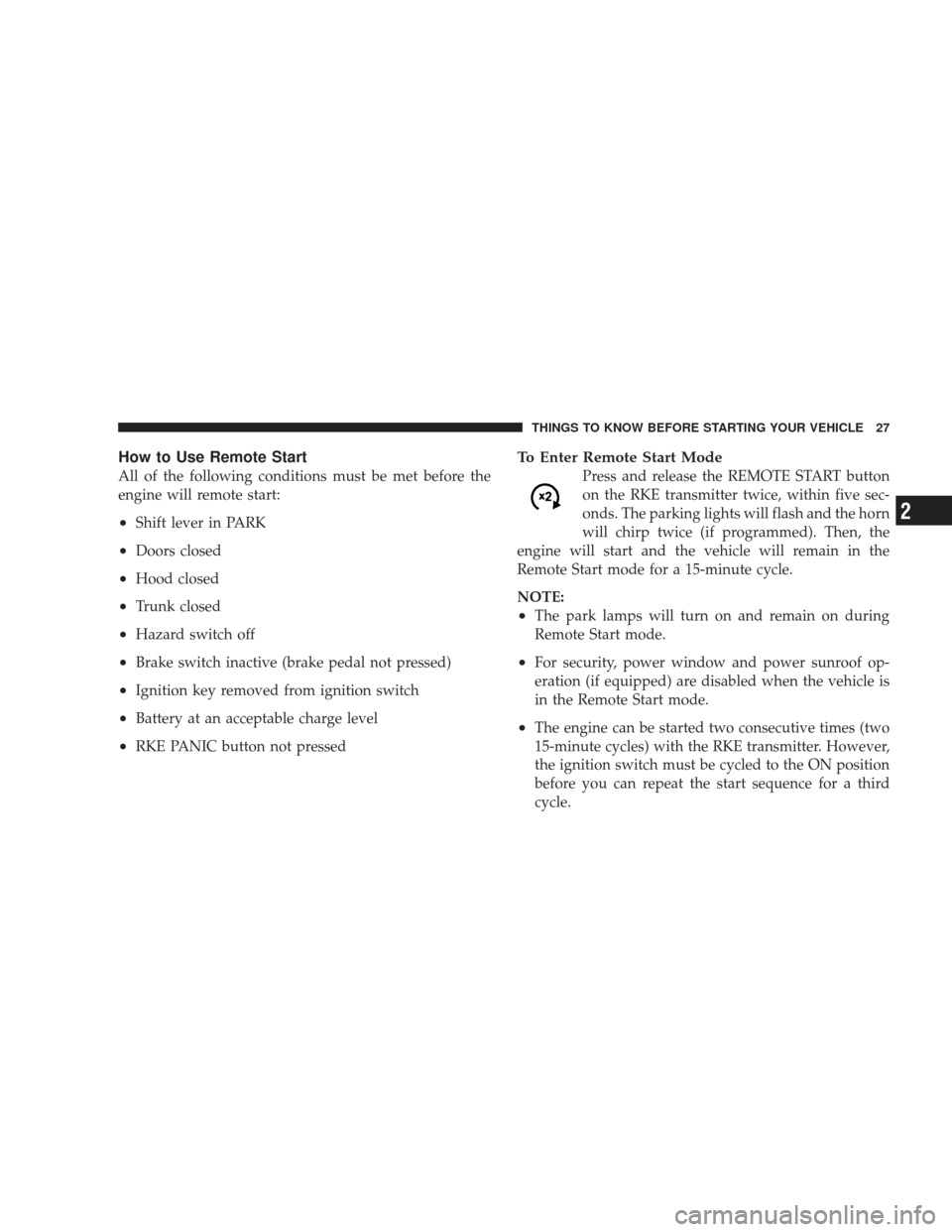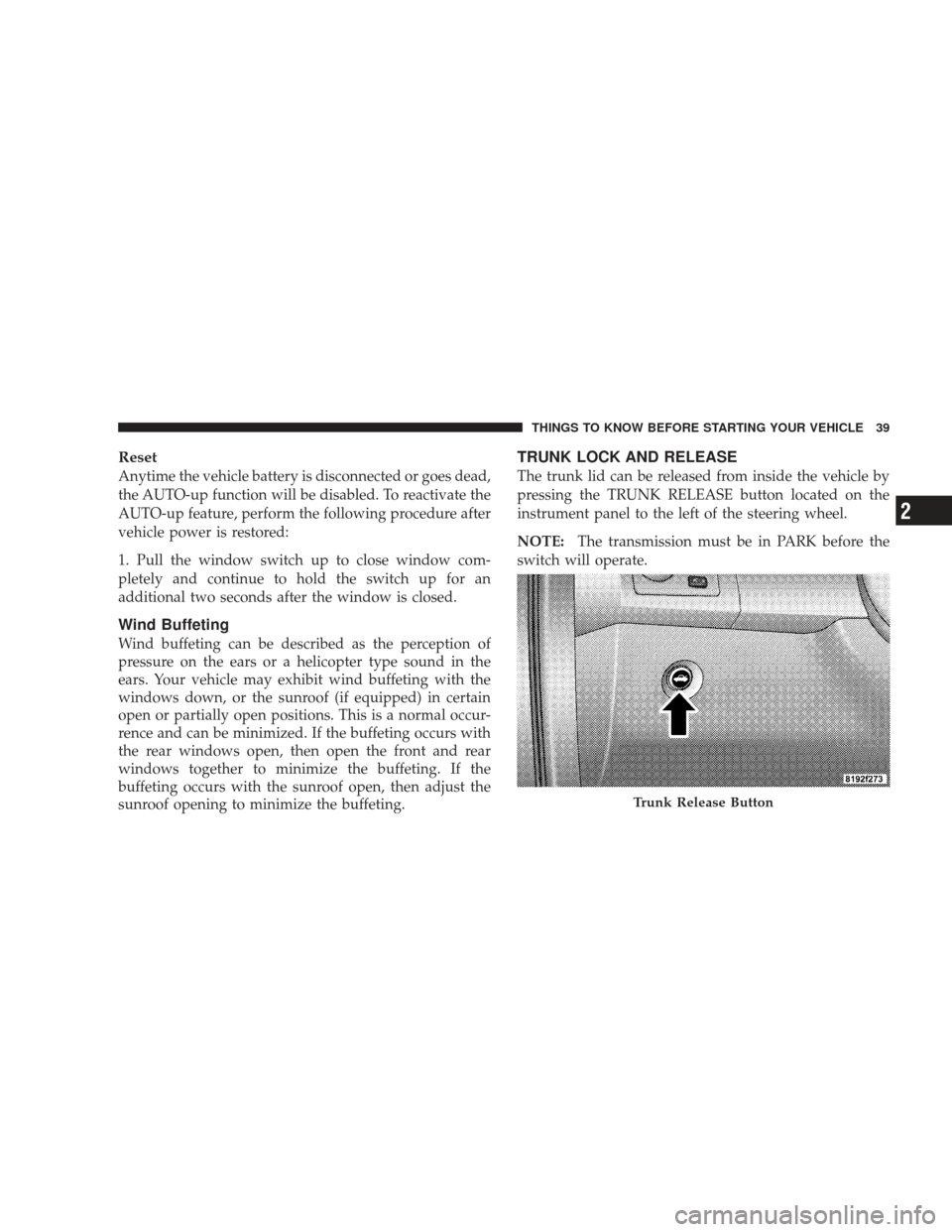Page 12 of 484

▫Programming Additional Transmitters ...... 24
▫ Transmitter Battery Service .............. 25
▫ General Information ................... 26
� Remote Starting System — If Equipped ....... 26
▫ How To Use Remote Start ............... 27
� Door Locks ........................... 29
▫ Manual Door Locks ................... 29
▫ Power Door Locks .................... 30
▫ Child Protection Door Lock .............. 33
� Windows ............................ 35
▫ Power Windows ...................... 35
▫ Wind Buffeting ....................... 39
� Trunk Lock And Release ................. 39 �
Trunk Safety Warning ................... 40
▫ Trunk Emergency Release ............... 41
� Occupant Restraints ..................... 41
▫ Lap/Shoulder Belts .................... 42
▫ Lap/Shoulder Belt Untwisting Procedure .... 48
▫ Seat Belt Pretensioners ................. 49
▫ Enhanced Seat Belt Use Reminder System
(BeltAlert�) ......................... 49
▫ Automatic Locking Mode — If Equipped .... 51
▫ Seat Belts And Pregnant Women .......... 51
▫ Seat Belt Extender ..................... 52
▫ Driver And Front Passenger Supplemental
Restraint System (SRS) - Airbag ........... 52
▫ Event Data Recorder (EDR) .............. 65
10 THINGS TO KNOW BEFORE STARTING YOUR VEHICLE
Page 15 of 484
Fob with Integrated Key
The Fob with Integrated Key (FOBIK) operates the igni-
tion switch. It also contains the Remote Keyless Entry
(RKE) transmitter and a valet key, which stores in the rear
of the Fob.
The valet key allows for entry into the vehicle should the
battery in the vehicle or the Fob go dead. The valet key is
also for locking the glove box. You can keep the valet key
with you when valet parking.
To remove the valet key from the Fob, slide the mechani-
cal latch at the top of the Fob sideways with your thumb
and then pull the key out of the Fob with your other
hand.NOTE:
You can insert the double-sided valet key into
the lock cylinders with either side up.
Ignition Key Removal
Place the shift lever in PARK. Turn the key to the LOCK
position and then remove the key.
Valet Key Removal
THINGS TO KNOW BEFORE STARTING YOUR VEHICLE 13
2
Page 21 of 484

the Vehicle Security Alarm will cancel the arming pro-
cess. If you wish to rearm the Vehicle Security Alarm after
closing the door, you must repeat one of the previously-
described arming sequences.
To Disarm the System
Either press the UNLOCK button on the RKE transmitter
or insert a valid ignition key into the ignition switch and
turn the key to the ON position.
NOTE:
•The driver’s door key cylinder and the trunk button on
the RKE transmitter cannot arm or disarm the Vehicle
Security Alarm.
•The Vehicle Security Alarm remains armed during
trunk entry. Pressing the TRUNK button will not
disarm the Vehicle Security Alarm. If someone enters
the vehicle through the trunk, and opens any door, the
alarm will sound.
•When the Vehicle Security Alarm is armed, the interior
power door lock switches will not unlock the doors.
The Vehicle Security Alarm is designed to protect your
vehicle; however, you can create conditions where the
Vehicle Security Alarm will give you a false alarm. If one
of the previously-described arming sequences has oc-
curred, the Vehicle Security Alarm will arm regardless of
whether you are in the vehicle or not. If you remain in the
vehicle and open a door, the alarm will sound. If this
occurs, disarm the Vehicle Security Alarm.
If the Vehicle Security Alarm is armed and the battery
becomes disconnected the Vehicle Security Alarm will
remain armed when the battery is reconnected. The
exterior lights will flash, the horn will sound, and the
ignition will not start the vehicle. If this occurs, disarm
the Vehicle Security Alarm.
THINGS TO KNOW BEFORE STARTING YOUR VEHICLE 19
2
Page 27 of 484
Transmitter Battery Service
The recommended replacement battery is one CR2032
battery.
NOTE:
•Do not touch the battery terminals that are on the back
housing or the printed circuit board.
1. Battery access is through a door located on the rear of
the RKE transmitter. Insert a small, flat blade screwdriver
into the slot and gently pry open the access door.
2. Remove and replace the batteries. Avoid touching the
new batteries with your fingers. Skin oils may cause
battery deterioration. If you touch a battery, clean it with
rubbing alcohol.
Battery Replacement
1— Battery Access DoorTHINGS TO KNOW BEFORE STARTING YOUR VEHICLE 25
2
Page 28 of 484

3. Reposition the access door panel over the battery
opening and snap into place.
General Information
This device complies with Part 15 of the FCC rules and
RSS 210 of Industry Canada. Operation is subject to the
following conditions:
•This device may not cause harmful interference.
•This device must accept any interference received,
including interference that may cause undesired
operation.
NOTE: Changes or modifications not expressly ap-
proved by the party responsible for compliance could
void the user’s authority to operate the equipment.
If your RKE transmitter fails to operate from a normal
distance, check for these two conditions: 1. A weak battery in the RKE transmitter. The expected
life of the battery is a minimum of three years.
2. Closeness to a radio transmitter such as a radio station
tower, airport transmitter, and some mobile or CB radios.
REMOTE STARTING SYSTEM — IF EQUIPPED
This system uses the Remote Keyless Entry
(RKE) transmitter to start the engine conve-
niently from outside the vehicle while still
maintaining security. The system has a range of
328 ft (100 m).
NOTE: The vehicle must be equipped with an auto-
matic transmission to be equipped with Remote Start.
26 THINGS TO KNOW BEFORE STARTING YOUR VEHICLE
Page 29 of 484

How to Use Remote Start
All of the following conditions must be met before the
engine will remote start:
•Shift lever in PARK
•Doors closed
•Hood closed
•Trunk closed
•Hazard switch off
•Brake switch inactive (brake pedal not pressed)
•Ignition key removed from ignition switch
•Battery at an acceptable charge level
•RKE PANIC button not pressed
To Enter Remote Start Mode
Press and release the REMOTE START button
on the RKE transmitter twice, within five sec-
onds. The parking lights will flash and the horn
will chirp twice (if programmed). Then, the
engine will start and the vehicle will remain in the
Remote Start mode for a 15-minute cycle.
NOTE:
•The park lamps will turn on and remain on during
Remote Start mode.
•For security, power window and power sunroof op-
eration (if equipped) are disabled when the vehicle is
in the Remote Start mode.
•The engine can be started two consecutive times (two
15-minute cycles) with the RKE transmitter. However,
the ignition switch must be cycled to the ON position
before you can repeat the start sequence for a third
cycle.
THINGS TO KNOW BEFORE STARTING YOUR VEHICLE 27
2
Page 41 of 484

Reset
Anytime the vehicle battery is disconnected or goes dead,
the AUTO-up function will be disabled. To reactivate the
AUTO-up feature, perform the following procedure after
vehicle power is restored:
1. Pull the window switch up to close window com-
pletely and continue to hold the switch up for an
additional two seconds after the window is closed.
Wind Buffeting
Wind buffeting can be described as the perception of
pressure on the ears or a helicopter type sound in the
ears. Your vehicle may exhibit wind buffeting with the
windows down, or the sunroof (if equipped) in certain
open or partially open positions. This is a normal occur-
rence and can be minimized. If the buffeting occurs with
the rear windows open, then open the front and rear
windows together to minimize the buffeting. If the
buffeting occurs with the sunroof open, then adjust the
sunroof opening to minimize the buffeting.
TRUNK LOCK AND RELEASE
The trunk lid can be released from inside the vehicle by
pressing the TRUNK RELEASE button located on the
instrument panel to the left of the steering wheel.
NOTE:The transmission must be in PARK before the
switch will operate.
Trunk Release Button
THINGS TO KNOW BEFORE STARTING YOUR VEHICLE 39
2
Page 65 of 484

However, if you haven’t healed significantly within a
few days or if you have any blistering, see your doctor
immediately.
•As the airbags deflate, you may see some smoke-like
particles. The particles are a normal by-product of the
process that generates the nontoxic gas used for airbag
inflation. These airborne particles may irritate the skin,
eyes, nose, or throat. If you have skin or eye irritation,
rinse the area with cool water. For nose or throat
irritation, move to fresh air. If the irritation continues,
see your doctor. If these particles settle on your
clothing, follow the garment manufacturer’s instruc-
tions for cleaning.
•It is not advisable to drive your vehicle after the
airbags have been deployed. If you are involved in
another collision, the airbags will not be in place to
protect you.
WARNING!
Deployed airbags can’t protect you in another colli-
sion. Have the airbags replaced by an authorized
dealer as soon as possible.
Enhanced Accident Response System
In the event of an impact that causes airbag deployment,
with the vehicle stopped, and the vehicle communication
network intact, and the power intact, the Enhanced
Accident Response System performs the following func-
tions:
•Cuts off fuel to the engine.
•Flashes hazard lights.
•Turns on the interior lights, which remain on as long as
the battery has power or until the ignition key is
removed.
THINGS TO KNOW BEFORE STARTING YOUR VEHICLE 63
2